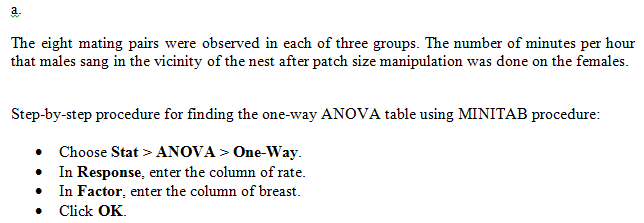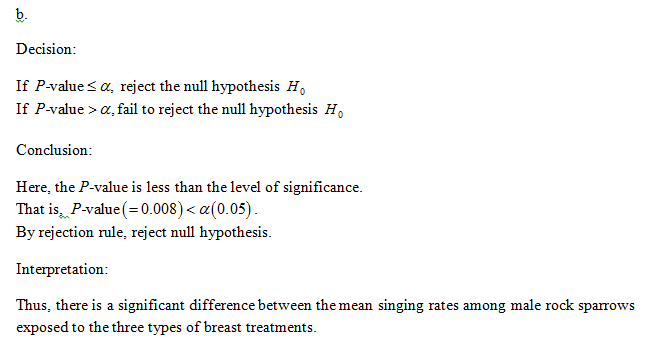
Concept explainers
Rock Sparrows. Rock Sparrows breeding in northern Italy are the subject of a long-term ecology and conservation study due to their wide variety of breeding patterns. Both males and females have a yellow patch on their breasts that is thought to play a significant role in their sexual behavior. A. Pilastro et al. conducted an experiment in which they increased or reduced the size of a female’s breast patch by dying feathers at the edge of a patch and then observed several characteristics of the behavior of the male. Their results were published in the paper “Male Rock Sparrows Adjust Their Breeding Strategy According to Female Ornamentation: Parental or Mating Investment?” (Animal Behaviour,Vol. 66, Issue 2, pp. 265–271). Eight mating pairs were observed in each of three groups: a reduced-patch-size group, a control group, and an enlarged-patch-size group. The data on the WeissStats site, based on the results reported by the researchers, give the number of minutes per hour that males sang in the vicinity of the nest after the patch size manipulation was done on the females. At the 1% significance level, do the data provide sufficient evidence to conclude that a difference exists in the mean singing rates among male Rock Sparrows exposed to the three types of breast treatments?
a. conduct a one-way ANOVA test on the data.
b. interpret your results from part (a).
c. decide whether presuming that the assumptions of normal populations and equal population standard deviations are met is reasonable.



Step by stepSolved in 3 steps with 6 images

- Suppose that you wanted to design an investigation that examined the association between energy drink consumption and social interaction. You select your sample population and begin making your observations. As the research progresses, you suspect that a number of the subjects exhibit behavioral changes simply related to their knowledge of being enrolled in the study and the increased attention they are receiving as subjects. This phenomenon is known as: Group of answer choices selection bias the Hawthorne effect healthy participant effect misclassification error the Rosenthal effectarrow_forwardIn the article “The Eastern Cottonmouth (Agkistrodon piscivorus) at the Northern Edge of Its Range” (Journal of Herpetology, Vol. 29, No. 3, pp. 391–398), Blem and Blem examined the reproductive characteristics of the eastern cottonmouth, a once widely distributed snake whose numbers have decreased recently due to encroachment by humans. A simple random sample of 44 female cottonmouths yielded a sample mean of ??̅ = 7.6 young per litter. Assume σ = 2.4. a. Is the sample mean likely to equal μ exactly? Explain your answer b. Find the 95% Confidence Interval. c. How large a sample would be needed to get at 99% confidence interval with a margin of error of just 0.1?arrow_forwardTrematodes of the species Euhaplorchis californiensis may infect the California kill fish, Fundulus parvipinnis. Researchers have observed that infected fish spend excessive time near the water surface, where they may be more vulnerable to bird predation. Researchers set up an experiment in a large outdoor tank that stocked with three kinds of killifish, uninfected, lightly infected, and highly infected, and recorded the number of fish that is eaten by birds. State the null and alternative hypothesisarrow_forward
- A warehouse manager wants to know if there is an association between the shift worked and being on time for work. To investigate, he selects a random sample of 70 workers and classifies each one according to the shift they worked most recently and whether they were on time for work. He was unable to classify a substantial number of people as being on time, so he classified those individuals as unknown. The data are displayed in the table. The manager would like to know if these data provide convincing evidence of an association between the shift worked and being on time in the large population of all workers at this warehouse. The random and 10% conditions are met. Is the Large Counts condition met? Yes, the smallest expected count is 5, so all expected counts are at least 5. Yes, the smallest expected count is 8.54, so all expected counts are at least 5. No, the smallest expected count is 2.56, so the expected counts are not all at least 5. No, the smallest expected count is…arrow_forwardSection 3.1, question 3arrow_forwardA study was conducted to determine whether big-city and small-town dwellers differed in their helpfulness to strangers. In this study, the investigators rang the doorbells of strangers living in a large City or small towns in the vicinity. They explained they had misplaced the address of a friend living in the neighbourhood and asked to use the phone. The following data show the number of individuals who admitted or did not admit the strangers (the investigators) into their homes: Helpfulness to strangers Admitted strangers into their home Didnot admit strangers into their home Big city dwellers 60 90 Small town dwellers 70 30 State the dependent and independent variable Is this a directional or non directionalarrow_forward
- Recent research findings have shown that older people who practice ballroom dancing are 77% less likely to experience dementia compared to those senior citizens who did not dance. Drawing on this surprising result, Dr. Anders Ericsson thinks that ballroom dancing may also reduce one's level of stress to a greater extent than conventional exercise routines. To validate his claim Dr. Ericsson has randomly selected 100 senior citizens who were then randomly split into two groups, with the first group practicing ballroom dancing 3 times a week and the second group undergoing a conventional exercise regiment 3 times a week also. The measures of stress were assessed for each participant after the study was completed. What is the most appropriate set of hypotheses for this study? HO: μD- 0; H1: μD 0 HO: µD = 0; H1: µD > 0 %3D HO: udance - pexercise = 0; H1: µdance - pexercise <0arrow_forwardThe American Society for Microbiology (ASM) and the Soap and Detergent Association (SDA) jointly commissioned two separate studies during 2007, both of which were conducted by Harris Interactive. In one of the studies, 1001 adults were interviewed by telephone and asked about their hand-washing habits. In the other study, the hand-washing behavior of 6076 adults was inconspicuously observed within public restrooms in four U.S. cities. Address the following: a. In the telephone interviews, 921 of the adults said they always wash their hands in public restrooms. Use this result to obtain a point estimate for the proportion of adults who say they always wash their hands in public restrooms. b. Verify that the requirements for constructing a confidence interval for p from part (a) are satisfied. c. Using the results from the telephone interviews, construct and interpret a 95% confidence interval for the proportion of adults who say they always wash their hands in public restrooms. d. Is it…arrow_forward
 MATLAB: An Introduction with ApplicationsStatisticsISBN:9781119256830Author:Amos GilatPublisher:John Wiley & Sons Inc
MATLAB: An Introduction with ApplicationsStatisticsISBN:9781119256830Author:Amos GilatPublisher:John Wiley & Sons Inc Probability and Statistics for Engineering and th...StatisticsISBN:9781305251809Author:Jay L. DevorePublisher:Cengage Learning
Probability and Statistics for Engineering and th...StatisticsISBN:9781305251809Author:Jay L. DevorePublisher:Cengage Learning Statistics for The Behavioral Sciences (MindTap C...StatisticsISBN:9781305504912Author:Frederick J Gravetter, Larry B. WallnauPublisher:Cengage Learning
Statistics for The Behavioral Sciences (MindTap C...StatisticsISBN:9781305504912Author:Frederick J Gravetter, Larry B. WallnauPublisher:Cengage Learning Elementary Statistics: Picturing the World (7th E...StatisticsISBN:9780134683416Author:Ron Larson, Betsy FarberPublisher:PEARSON
Elementary Statistics: Picturing the World (7th E...StatisticsISBN:9780134683416Author:Ron Larson, Betsy FarberPublisher:PEARSON The Basic Practice of StatisticsStatisticsISBN:9781319042578Author:David S. Moore, William I. Notz, Michael A. FlignerPublisher:W. H. Freeman
The Basic Practice of StatisticsStatisticsISBN:9781319042578Author:David S. Moore, William I. Notz, Michael A. FlignerPublisher:W. H. Freeman Introduction to the Practice of StatisticsStatisticsISBN:9781319013387Author:David S. Moore, George P. McCabe, Bruce A. CraigPublisher:W. H. Freeman
Introduction to the Practice of StatisticsStatisticsISBN:9781319013387Author:David S. Moore, George P. McCabe, Bruce A. CraigPublisher:W. H. Freeman





